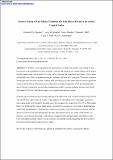Relative timing of last glacial maximum and late-glacial events in the central tropical Andes

View/
Date
2009-06-18Author
Bromley, Gordon R. M.
Schaefer, Joerg M.
Winckler, Gisela
Hall, Brenda L.
Todd, Claire E.
Rademaker, Kurt M.
Metadata
Show full item recordUsage
This item's downloads: 360 (view details)
Cited 45 times in Scopus (view citations)
Recommended Citation
Bromley, Gordon R. M., Schaefer, Joerg M., Winckler, Gisela, Hall, Brenda L., Todd, Claire E., & Rademaker, Kurt M. (2009). Relative timing of last glacial maximum and late-glacial events in the central tropical Andes. Quaternary Science Reviews, 28(23), 2514-2526. doi: https://doi.org/10.1016/j.quascirev.2009.05.012
Published Version
Abstract
Whether or not tropical climate fluctuated in synchrony with global events during the Late Pleistocene is a key problem in climate research. However, the timing of past climate changes in the tropics remains controversial, with a number of recent studies reporting that tropical ice age climate is out of phase with global events. Here, we present geomorphic evidence and an in-situ cosmogenic (3)He surface-exposure chronology from Nevado Coropuna, southern Peru, showing that glaciers underwent at least two significant advances during the Late Pleistocene prior to Holocene warming. Comparison of our glacial-geomorphic map at Nevado Coropuna to mid-latitude reconstructions yields a striking similarity between Last Glacial Maximum (LGM) and Late-Glacial sequences in tropical and temperate regions. Exposure ages constraining the maximum and end of the older advance at Nevado Coropuna range between 24.5 and 25.3 ka, and between 16.7 and 21.1 ka, respectively, depending on the cosmogenic production rate scaling model used. Similarly, the mean age of the younger event ranges from 10 to 13 ka. This implies that (1) the LGM and the onset of deglaciation in southern Peru occurred no earlier than at higher latitudes and (2) that a significant Late-Glacial event occurred, most likely prior to the Holocene, coherent with the glacial record from mid and high latitudes. The time elapsed between the end of the LGM and the Late-Glacial event at Nevado Coropuna is independent of scaling model and matches the period between the LGM termination and Late-Glacial reversal in classic mid-latitude records, suggesting that these events in both tropical and temperate regions were in phase. (c) 2009 Elsevier Ltd. All rights reserved.

